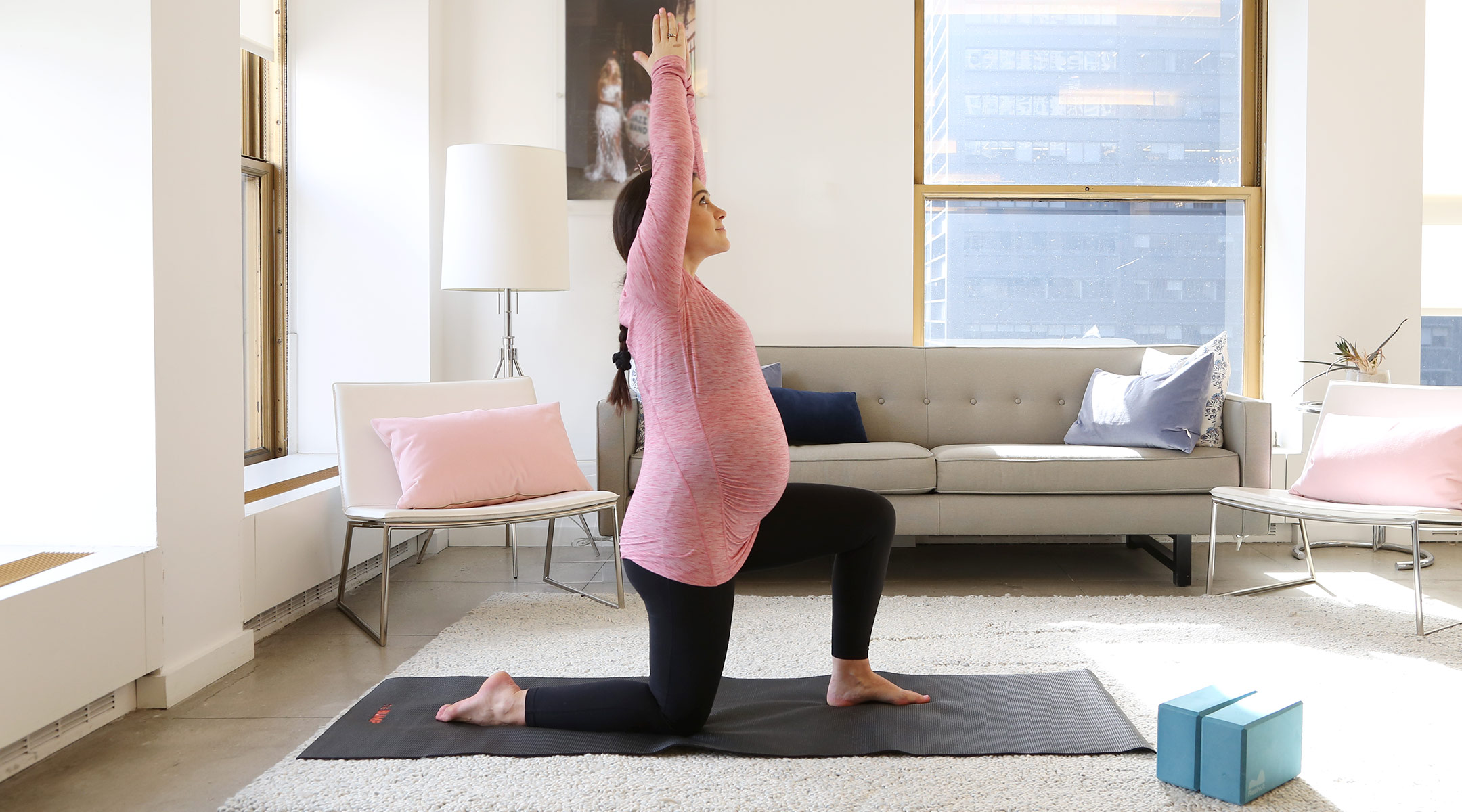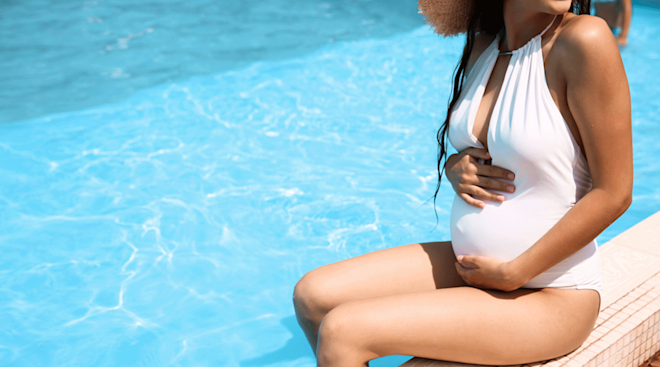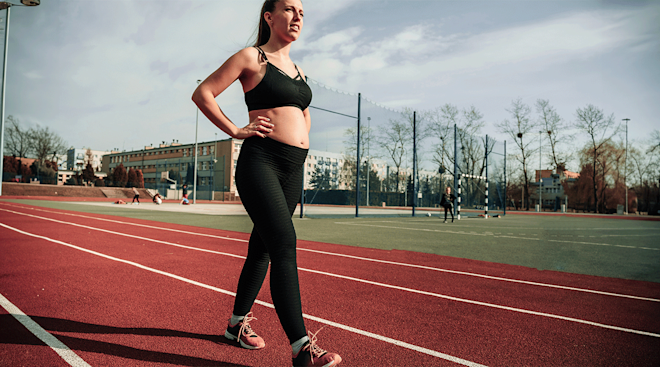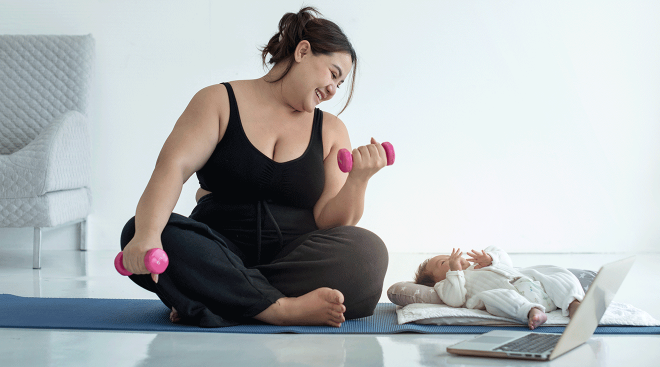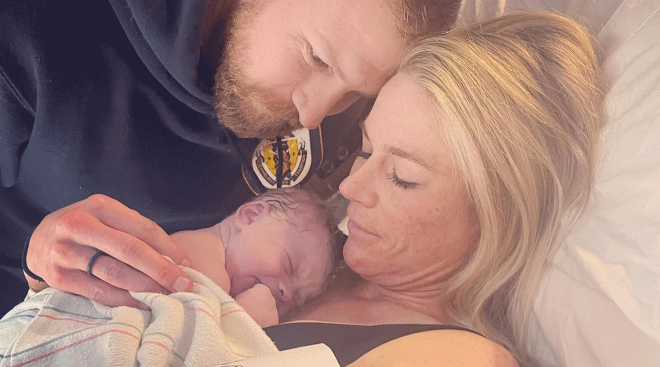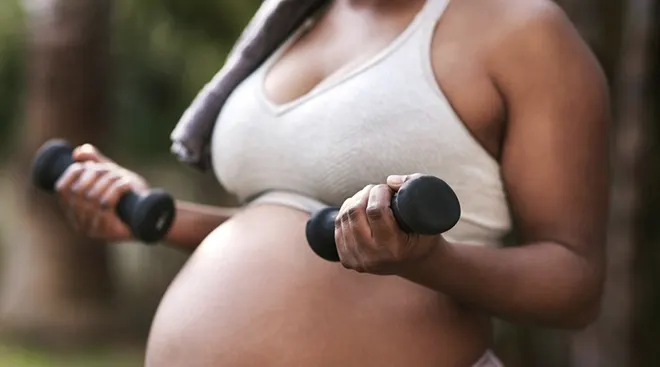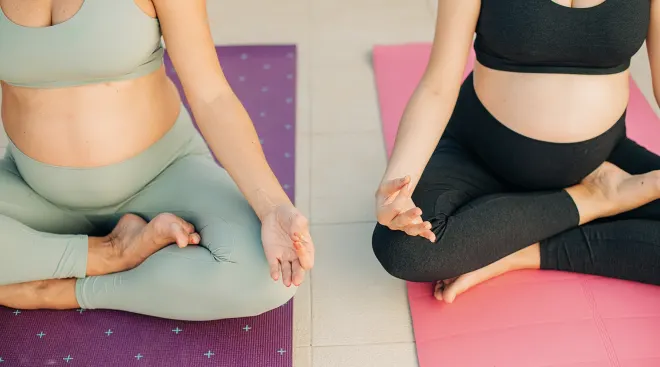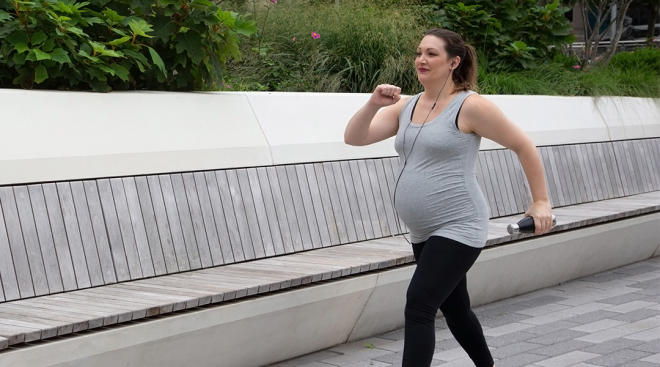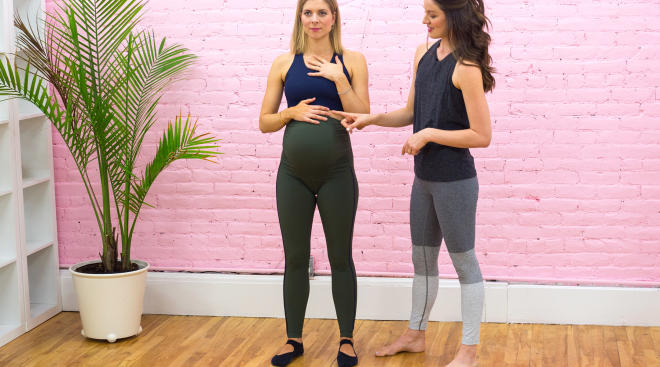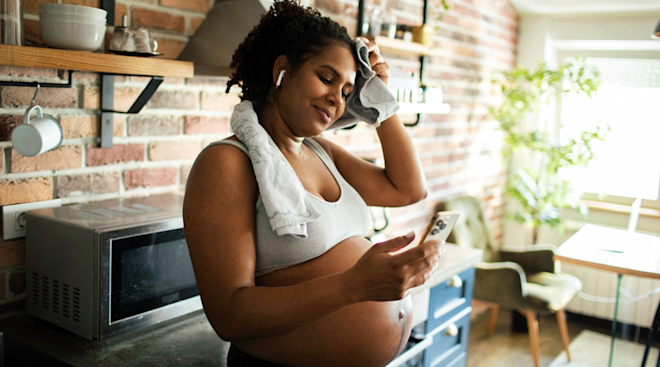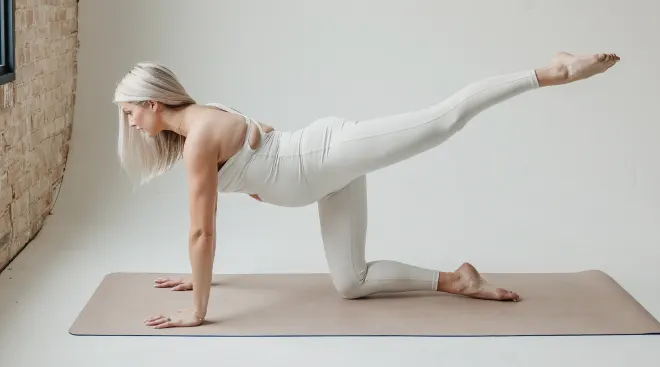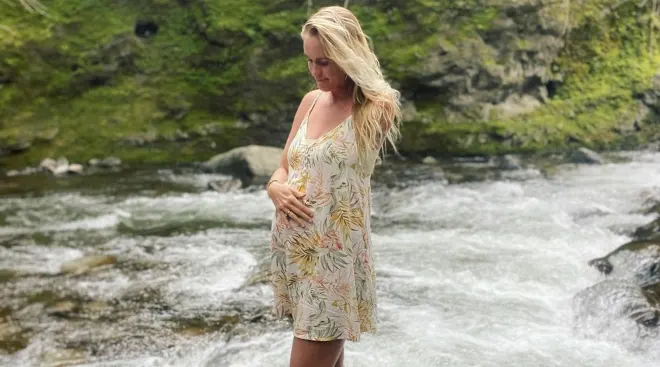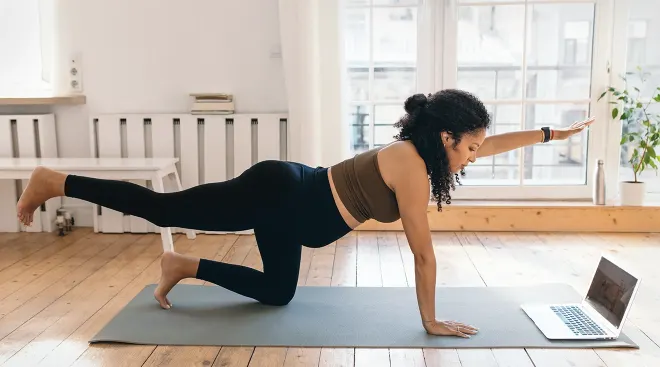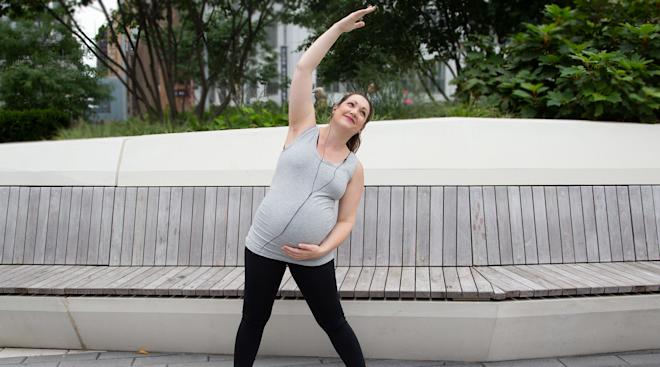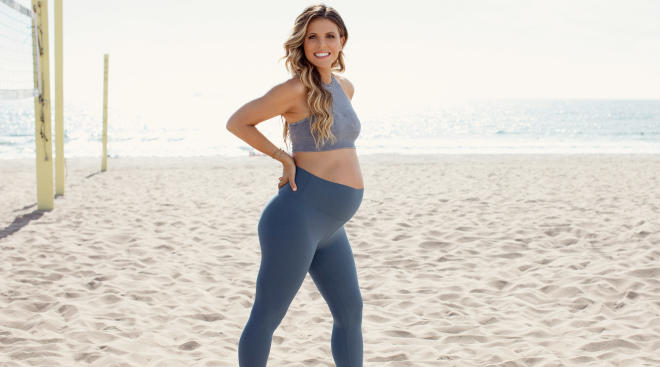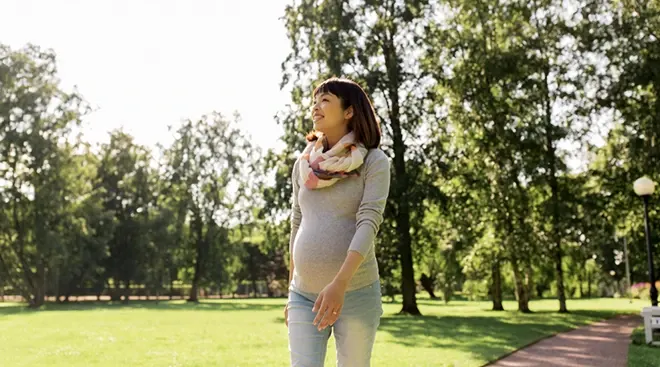12 Yoga Moves to Ease Uncomfortable Pregnancy Symptoms
Pregnancy stretches us to our limits, prompting an assortment of aches and pains—from round ligament pain to back pain, gas pain and more, most moms-to-be become intimately familiar with some discomfort along their pregnancy journey. The good news? There’s something to be done about it! Certain yoga poses can not only help ease common pregnancy symptoms, but they can also help you recenter and release your mounting stress.
“The poses can be anatomically great and help our bodies, but yoga also teaches us how to be present and in the moment—which can be difficult during pregnancy when there’s so much focus on future and what happens next,” says Jennifer More, E-RYT 500, RPYT, a prenatal yoga teacher, doula, and hypnotherapist based in Santa Rosa, California.
Curious to learn which yoga moves can help alleviate which pregnancy pains and problems? Read on.
The overarching end-goal of these poses is to help ease any discomfort you’re currently experiencing—so it would be pretty counterproductive to suffer an injury. Listen to your body and be careful not to overstretch, which pregnant women are more susceptible to doing thanks to the added weight of your belly and the pregnancy hormones that are lubricating your connective tissue and joints. The hormone relaxin, which helps support early pregnancy and ramps up in the third trimester to prepare you for labor, can also make you more prone to hypermobility or overstretching, so it’s important that you don’t push yourself to your max.
“If you’re in a Wide-Legged Forward Fold during pregnancy and your hands can suddenly touch the ground, it doesn’t mean that they should,” says Allie Geer, E-RYT 500, RPYT, a registered yoga medicine therapeutic specialist and prenatal yoga teacher based in Boulder, Colorado. “Don’t go to the depths of your flexibility or hang out in your end range of motion. Come out of it a little bit and use props to support you.” If anything is painful or doesn’t feel good, stop immediately.
More recommends starting a prenatal practice in a seated position, such as Sukhasana (Easy Pose), and simply focusing on your breath for a few minutes. “There can be so much anxiety with all the tests you’re getting and all the newness and the huge transformational time this is, so breathing is one of the simplest and most important things you can do to start to find balance,” More says.
Tune into your breath and simply observe each inhale and exhale. Notice any rising and falling of your belly. After a few minutes, you can start moving in a gentle rocking motion along with your breath, which should help deepen it and give you a focus to help quiet the mind chatter and activate your parasympathetic (rest and digest) nervous system to give you a sense of calm. (This same rocking with your breath can also be helpful in labor.) You can also start moving your head and shoulders, doing some gentle side bends and moving your hands behind you for a gentle backbend.
Belly breathing can help minimize your discomfort during daily movements, such as getting out of bed or in and out of the car. “Belly breathing helps you connect to the layers of your core and draw your abdominals in gently to feel more support,” Geers says.
After taking some grounding breaths in Sukhasana (sitting cross-legged), place your hands out toward the sides of your belly. On an inhalation, feel your belly swell into your hands. On the exhalation, draw your fingers in toward your navel and sense that you’re hugging in around your belly, like you’re giving baby an internal hug, Geer says. You can also try making a “shhh” or “haa” sound on the exhale to feel how your abdominals have to draw in slightly to make this sound—that’s the gentle engagement you’re going for. As you hug in, you’re engaging your transverse abdominis, the deep abdominal muscles that wrap around your torso like a corset. On each exhale you’re gently fastening the corset for support, Geer says, which can be especially helpful if you’re experiencing back pain or round ligament pain. Continue this breathing pattern for three to five minutes; use it throughout your yoga practice and your day.
“If I had to pick only one yoga position to tell pregnant women to do daily, it would be Cat-Cow,” More says. “It helps take pressure off the lower back and can gently stretch and support the ligaments that connect the uterus to the pelvis.” If you’ve been sitting a lot, the contractile tissue of the round ligaments may pull your uterus into a position that leads to discomfort and back pain, she says. Cat-Cow can serve as a reset.
Come onto your hands and knees with your hands directly under your shoulders and your knees directly under your hips. Bring your index finger forward, which will spin your hands out a couple inches to externally rotate your arms, which allows more space between your shoulders. (If you have any discomfort in your wrists, put blocks under your palms.) On an exhalation, move into Cat Pose by gently rounding your back, releasing your head and relaxing your neck. Imagine that you’re gently bringing baby in toward your body with a hug that goes all the way to your lower back. This is a gentle hugging —you don’t want to be too aggressive. It’s just to allow a slight muscular engagement so your lower back is supported. On your inhalation, lift your head up and allow a very slight sway in your back for Cow Pose. Repeat three or four cycles of Cat-Cow.
During pregnancy, your uterus expands from roughly the size of an apple to the size of a watermelon. That’s a lot of stretching! No wonder it can hurt a bit—officially known as round ligament pain. One of the best things to ease that pain is to use the belly breath to hug in on an exhale to offer support while you transition between poses or get up from lying or sitting down, Geer says.
To warm up your round ligaments for more movements, do some alternate leg extensions after Cat-Cow, More says. This may help settle your ligaments and gently stretch the contractile tissue to prepare for bigger stretches, such as lunges.
From all fours, extend your left leg back, curl your toes under and press your heel back. Stay here, or lift your leg up gently. Hold for three breaths, then switch sides.
A yoga practice as a whole can help reduce stress—and let’s face it, expectant moms have a lot on their minds these days. “Taking time for yourself is so key,” Geer says. “It’s important to make yourself a priority and your practice a priority.” More suggests doing about 15 minutes of yoga a day, including a gentle form of Sun Salutations, to reduce stress and bring major areas of the pelvis into balance.
After warming up with Cat-Cows and Leg Extensions, stand with your feet hip-distance apart and a block between your feet. Inhale as you reach arms overhead. Exhale as you bend your knees and bring your arms out to your sides, resting your hands on your thighs or bringing your hands to a block (at any height) slightly forward of your feet. Inhale, then lengthen your spine to flat back.
Bring your right foot next to the block, then exhale as you step your left foot back into a lounge and place your knee down onto the ground. Your left knee should be in line with your left hand and your right hand should be in line with your right foot.
Once in the lunge, inhale, reach your arms up and bring your hips back so your hips are directly over your left knee. Exhale, gently hug baby in, and then lunge forward, making sure your knee doesn’t go past your ankle (to avoid overstretching). On an inhale, lengthen your spine and lift back up so your hips are once again over your back knee. Exhale, gently hug baby in, and then bring your hands back down to the ground. Bring both knees back into a wide-knee Child’s Pose. Inhale, then move to all fours. Exhale, then press up into Downward-Facing Dog. Inhale here. Exhale, place your knees back down and repeat the lunge sequence on the other side.
Carrying your growing baby around all day can be tiring work. Downward-Facing Dog takes weight off the pelvis and decreases that constant downward pressure you feel during pregnancy, says Geer.
Start on your hands and knees with your arms slightly forward, then lift your sit bones toward the sky and ground down through your hands. Keep your knees forward and gently press your heels down. Hold for at least three breaths.
As a modification, you can try an L-Shaped Pose. Stand facing a wall and bring your hands to the wall at shoulder height. Slowly walk your feet back so your arms and legs form an L shape. Press your hands into the wall and lengthen through the sides of your waist, reaching your sit bones toward the center of the room. Try not to collapse in your lower back or rib cage—instead, imagine a straight line from the crown of your head to your tailbone.
Your belly isn’t the only thing to get big during pregnancy—swelling in your legs and feet is super-common among moms-to-be, thanks to all that extra blood and fluid your body is generating. Good news: This yoga pose can take pressure off your feet and legs to potentially give you some relief, Geer says.
Position a bolster near a wall at a 45-degree angle with one edge on the ground and the other resting on two blocks, one at medium height and the other at a low height; you can also prop up a couple pillows. Leave enough space between the bolster and the wall for you to sit. Bring your left hip right up next to the bolster and lower down from your side, mindfully rolling onto your back so it’s resting on the bolster. Take your legs up the wall. (You can also put your feet up against a chair or even your couch.) Stay for about five minutes, focusing on your breath, and imagine the swelling reducing and fluid draining out of your legs. If at any time you feel dizzy or nauseous, rock over to your side
Pregnancy can bring out some seriously impressive burps. (Chalk it up to those hormones!) And when things aren’t bubbling up, you might be feeling stopped up. Any movement in a yoga practice can help get things moving, but open twists can be particularly effective, Geer says. It’s important to always twist away from your body instead of toward your body in order to avoid compressing your belly.
Sit in a cross-legged position and gently move to the right, bringing your right hand slightly behind your waist. Return to center and twist to the left, bringing your left hand slightly behind you.
As baby grows, all that pressure can lead to pelvic pain. Not only can opening your pelvis help relieve the discomfort, but later in pregnancy it can also encourage baby to drop down and help prep your body for childbirth. More recommends a series of three poses to target the entire pelvis: Squats to open up the bottom of the pelvis, Side Lunge to open the middle of the pelvis and Baddha Konasana to open up the top of the pelvis.
Squats
Begin with a squat. Stand over a bolster with your feet parallel. Inhale and reach your arms up. Exhale, bend your knees and bring your arms out to the sides to move into a forward fold with your hands on the bolster. Slightly turn your feet out, bend your knees, and move into a squat. Bring your palms together in front of your chest and gently rest your elbows on the inside of your thighs. (If this arm placement isn’t comfortable, you can place a block on top of the bolster and rest your hands on it, or you can lean your back against a wall.) Hold for up to two minutes. Return to standing and do some hip circles as if you were using a hula hoop.
Side Lunges
To practice Side Lunges, move onto all fours and bring your right leg out to the side so that your right heel is in line with your left knee and your right toes are pointing out toward the right. Walk your hands forward and a little bit wide. Lunge to the side slightly to see if this is comfortable. Everyone’s hips are shaped differently, so you may need to move your foot a little forward or angle it more. (You can also do a Side Lunge from kneeling with your torso upright or from standing by bringing your right foot onto a chair.) Stay for up to one minute or lunge back and forth.
Bound Angle Pose
For Bound Angle Pose (Baddha Konasana), move into an upright seated position and bring the soles of your feet together. Let your knees drop onto pillows, rolled blankets or blocks. Bring your hands behind you to lengthen your spine and stay here or move forward with a flat back. Stay for up to a minute.
Growing a baby is tiring work—and yet getting a night of sound sleep gets harder and harder as pregnancy progresses, thanks to your aches and pains and racing thoughts. In the early evening, help yourself wind down by taking five minutes for a restorative pose, Geer says.
For Reclining Bound Angle Pose (Supta Baddha Konasana), position a bolster at a 45-degree angle with one edge on the ground and the other resting on two blocks. Put one block at medium height and the other at a low height. Bring your left hip right up next to the bolster and lower down from your side, mindfully rolling onto your back. Bring the soles of your feet together and bring your thighs to rest on pillows or rolled up blankets.
If you’re already in bed and having trouble sleeping, try following your breath and focusing on the exhales to help you enter a calmer state. Focusing on your breath can help you move from the sympathetic nervous system (fight or flight) to the parasympathetic nervous system (rest and digest), making it easier to drift off.
Please note: The Bump and the materials and information it contains are not intended to, and do not constitute, medical or other health advice or diagnosis and should not be used as such. You should always consult with a qualified physician or health professional about your specific circumstances.
Plus, more from The Bump:
Navigate forward to interact with the calendar and select a date. Press the question mark key to get the keyboard shortcuts for changing dates.
































